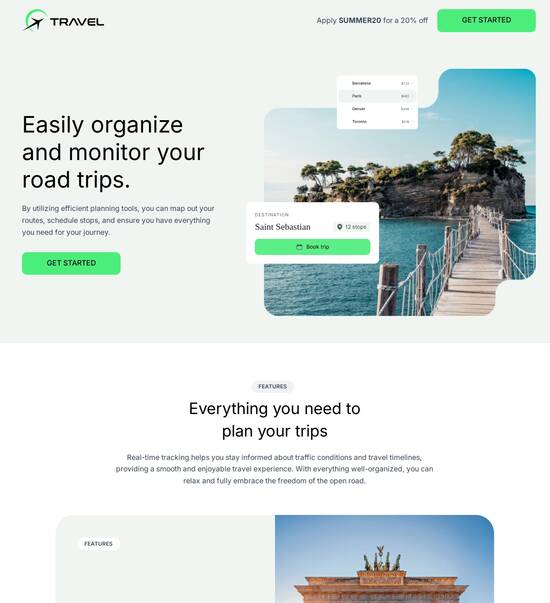
HTML page template for cloud computing providers
Use TemplateAbout template
Engage your audience like never before with stunning landing page templates for cloud computing providers. Make your online presence unforgettable!
Recommended templates

Easy to build without coding
With the intuitive drag-and-drop builder, anyone on your team can create high-converting pages without any knowledge of code or design. Make enhancements to your landing page with custom widgets using Javascript, HTML/CSS, or third-party scripts.

Multiple layouts for any industry and goal
Select from 500+ landing page layouts built to boost conversions across industry-specific scenarios. Customize them by adjusting fonts, adding images, and generating on-brand content with the AI assistant. Quickly scale with Instablocks® and Global Blocks that you can save, reuse, and update globally.

Loads fast and looks polished on any device
Every template is responsive, which means they present professionally on any device and load blazingly fast with our Thor Render Engine. You can also power them up with Google AMP technology to deliver an unparalleled mobile experience and drive higher conversions.

Robust analytics & experimentation
Get real-time updates and reporting across all your devices, showing the number of visitors, conversions, cost-per-visitor, and cost-per-lead. Launch AI-powered experiments, run A/B tests, and use heatmaps to analyze user behavior, then optimize your landing page to maximize conversions.







Easy to build without coding
With the intuitive drag-and-drop builder, anyone on your team can create high-converting pages without any knowledge of code or design. Make enhancements to your landing page with custom widgets using Javascript, HTML/CSS, or third-party scripts.
Multiple layouts for any industry and goal
Select from 500+ landing page layouts built to boost conversions across industry-specific scenarios. Customize them by adjusting fonts, adding images, and generating on-brand content with the AI assistant. Quickly scale with Instablocks® and Global Blocks that you can save, reuse, and update globally.
Loads fast and looks polished on any device
Every template is responsive, which means they present professionally on any device and load blazingly fast with our Thor Render Engine.
Robust analytics & experimentation
Get real-time updates and reporting across all your devices, showing the number of visitors, conversions, cost-per-visitor, and cost-per-lead. Launch AI-powered experiments, run A/B tests, and use heatmaps to analyze user behavior, then optimize your landing page to maximize conversions.
All the features you need to build cloud computing template
Explore more featuresLearn how to build cloud storage website template free
Frequently asked questions about computing html template
Leading the way in building high-performing landing pages





Create high-performing landing pages with Instapage
In a digital world where first impressions matter, an effective landing page can significantly enhance your marketing strategy. Instapage offers a powerful landing page creation and optimization platform, specially designed for marketers in the business services, tech/SaaS, education, and financial sectors. This guide will walk you through the key steps of leveraging Instapage's unique features to maximize the ROI of your digital campaigns.
Understanding the importance of landing pages
A landing page serves as the critical touchpoint between your ad campaigns and potential customers. With Instapage, you can design engaging landing pages that not only capture leads but also guide your visitors toward conversion. Here’s why focusing on landing page optimization is essential:
- Improved user engagement: Tailored content enhances the user experience, keeping visitors engaged.
- Higher conversion rates: Optimized pages drive more sales, sign-ups, or downloads.
- Better data collection: Capture valuable insights through integrated analytics tools.
Step 1: Choose the right template
Instapage provides over 100 high-converting templates designed to suit various industries and marketing goals. Selecting the right template is crucial for setting the right tone for your campaign. Consider these steps:
- Evaluate your target audience's needs: Identify the specific pain points your audience faces.
- Select templates that resonate with your brand: Ensure the aesthetics align with your overall branding.
- Leverage marketing insights: Use data to choose templates that have previously performed well in your niche.
Step 2: Customize your landing page content
Once you have selected a template, you can effortlessly customize it using Instapage’s drag-and-drop builder. Here are some key customization tips:
- Personalize your headlines for target segments: Use dynamic text replacement to speak directly to different audience segments.
- Include compelling CTAs: Clearly guide visitors on the next steps they should take, using action-driven language.
- Utilize visual elements effectively: Incorporate images and videos to make your page more engaging.
Step 3: Optimize for conversions
Optimization is crucial for achieving success with your landing page. Instapage provides various tools to ensure your page is performing at its best. Consider implementing the following:
- A/B testing: Use this feature to test different headlines, images, or CTAs, and analyze which version drives better results.
- Heatmaps: Analyze how users interact with your page to identify areas that need improvement.
- Analytics integration: Leverage analytics tools to monitor your page's performance metrics over time.
By following these steps, you can create a compelling landing page that significantly boosts your marketing efforts. Instapage empowers marketers with the necessary tools for successful campaign execution.
Start using Instapage today to transform your digital marketing strategies and maximize your ROI with custom landing pages tailored to your audience.
People also ask about HTML page template for cloud computing providers
HTML page templates for cloud computing providers
Understanding HTML page templates for cloud computing providers
HTML page templates play a critical role in the online presence of cloud computing providers. These templates serve as the foundational building blocks for creating visually appealing and functional web pages that convey essential information about services offered. By standardizing design elements and information layout, providers can improve user experience, ensuring visitors can easily navigate and understand their offerings.
Templates not only streamline web development processes but also enhance operational efficiency. By utilizing reusable sections and styles, developers can focus on delivering high-quality content rather than getting bogged down with individual page designs. This leads to faster deployment times, consistency across the website, and ultimately, a more professional appearance that fosters trust with potential customers.
The fundamental role of HTML page templates in cloud computing
HTML page templates serve multiple purposes in the domain of cloud computing. For instance, they are instrumental in deploying landing pages for Software as a Service (SaaS) products, which often require a polished and professional presentation to convert visitors into users. Effective templates can highlight key features, pricing plans, and benefits that entice potential customers. Alongside landing pages, case studies and testimonials can also be integrated, enhancing credibility and providing social proof of the service's effectiveness.
Moreover, HTML templates can serve as informational pages that elaborate on specific service offerings. These pages can feature detailed product descriptions, usage guides, and FAQs, all crucial for educating prospective clients. The importance of using templates across various aspects of a cloud provider's website cannot be overstated, as they not only improve usability but also increase the likelihood of conversions.
Deploying landing pages for SaaS products.
Showcasing case studies and testimonials.
Creating informational pages for service offerings.
Anatomy of an effective HTML page template
To create an effective HTML page template, it’s essential to focus on its structure. This begins with using semantic HTML, which not only improves SEO but also enhances accessibility for users with disabilities. Semantic elements like , , and contribute to a well-organized layout that aids search engines in understanding the page’s content. Header sections typically house navigation menus, branding, and introductory elements, while the body contains the main content, and the footer provides additional links and copyright information.
Beyond structural elements, certain key components should always be included in an HTML template. These components enhance user interaction and increase the chances of conversion. Call-to-action buttons need to be prominently placed to guide user journeys effectively. Additionally, well-structured navigation menus simplify user experience, allowing visitors to find the information they seek quickly. Collecting data through forms and displaying social proof, such as reviews and testimonials, further bolster a template’s effectiveness.
Call-to-action buttons.
Navigation menus.
Forms for data collection.
Social proof from testimonials and reviews.
Customization features for enhanced user engagement
For cloud computing providers, utilizing customization features in HTML templates can significantly impact user engagement. Dynamic content management is a powerful tool that allows templates to serve personalized content to users based on their behavior or demographics. This can be achieved through modular sections, which can be easily edited or replaced without the need for extensive coding expertise. By personalizing user experiences, providers can foster higher engagement rates and improve overall satisfaction.
Responsive design principles are another critical aspect of customization. In a world where users access websites through a myriad of devices, ensuring mobile optimization is essential. Using flexible grid layouts, scalable images, and CSS media queries allows HTML templates to adapt smoothly across various screen sizes. Best practices also include conducting regular user testing to assess how well content scales and ensuring that all elements maintain functionality and aesthetics regardless of device.
Leveraging event listeners for interactivity
Incorporating event listeners in HTML templates adds an essential layer of interactivity. By employing the document.addEventListener method, developers can specify actions that should occur in response to user actions, such as clicks or keyboard inputs. This level of interactivity can significantly enhance the user experience, as it allows websites to respond fluidly to user behavior. For example, an event listener can reveal additional information without refreshing the page, keeping users engaged.
Real-world applications of event listeners are abundant. They can be integrated into navigation menus to highlight active sections as users scroll through the page, facilitating easier navigation. Additionally, event listeners can trigger animations upon specific interactions, such ashover effects and click animations, that create a more engaging atmosphere. Implementing these types of features can turn a standard HTML template into a dynamic user interface that encourages visitors to explore further.
Ensuring fast and efficient load times
Fast load times are a critical component affecting user retention and satisfaction on cloud computing provider websites. To ensure speed and efficiency, several best practices can be employed to optimize performance. Minimizing HTML file size is a pivotal first step, achieved through clean code and eliminating unnecessary elements. Additionally, compressing images and using CSS sprites can significantly speed up loading processes, leading to faster and more responsive user experiences.
Utilizing asynchronous loading for scripts guarantees that the loading of essential resources does not hinder page display. By deferring non-critical JavaScript, developers can improve the perceived load time, contributing to a smoother browsing experience. Moreover, leveraging tools like Google PageSpeed Insights and GTmetrix allows providers to regularly monitor their page speed. These platforms analyze load time metrics and offer actionable recommendations to continually optimize performance.
Enhancing template accessibility and compliance
Accessibility standards are crucial in crafting HTML templates that reach a broad audience, including individuals with disabilities. Understanding the WCAG (Web Content Accessibility Guidelines) helps cloud computing providers create templates that are usable by everyone. By adhering to these guidelines, your templates not only become more inclusive but also cater to legal accessibility requirements, which may be enforced in many regions.
Implementing accessible features within the templates, such as ARIA roles and properties, ensures that screen readers effectively interpret the content. Additionally, ensuring efficient keyboard navigation is essential for users who do not rely on a mouse. By providing clear focus states and navigational cues, developers can significantly enhance accessibility, creating a web experience where all users can interact with cloud services seamlessly.
Deploying and testing HTML page templates in the cloud
To deploy and test HTML page templates effectively, integration with cloud services is paramount. Hosting templates through cloud providers allows for scalable solutions that can handle varying traffic loads. Providers like AWS, Azure, and Google Cloud Platform offer robust hosting options, enabling seamless template deployment and management. Choosing the right platform largely depends on resource requirements, budget constraints, and specific functionalities desired by the cloud service provider.
A/B testing stands out as a valuable practice in optimizing landing pages. By designating variations of a template, providers can run tests that reveal which designs or messaging resonate better with their audience. This testing should include various metrics, such as click-through rates and conversion rates, to comprehensively assess performance. Tools like Optimizely and Google Optimize provide solutions for tracking these metrics efficiently, enabling data-driven decisions that refine user engagement.
Future trends in HTML templates for cloud computing
The evolution of HTML templates is poised for significant advancements, especially with the rise of Progressive Web Apps (PWAs). These technologies bring rich, app-like capabilities to web pages, including offline capabilities and enhanced user engagement. Cloud computing providers can leverage HTML templates designed as PWAs to provide seamless experiences across devices, ultimately delivering a more compelling product to potential clients.
Furthermore, the role of artificial intelligence and automation in the creation of HTML templates is set to grow. AI tools can suggest design modifications based on user interactions, optimizing templates for better performance. Predictive analytics can help tailor content to individual user needs, making the experience more personalized. As automation technology evolves, the ability to rapidly develop and iterate HTML templates will become an invaluable resource for cloud providers, enhancing their responsiveness to market demands.
Real-world examples of successful HTML templates
Examining real-world case studies from leading cloud providers can provide vital insights into the effectiveness of HTML templates. For instance, successful landing pages often feature concise messaging, solid call-to-action placements, and compelling visuals that resonate with visitors. Analysis of these case studies frequently reveals that the integration of social proof, such as customer testimonials and statistics, significantly boosts credibility and encourages conversions.
Key lessons learned from these examples include the necessity of maintaining a clear and focused design. Cloud providers should strive to eliminate distractions that might draw users away from taking desired actions. Additionally, regular A/B testing and performance monitoring should be standards, enabling providers to continually enhance their templates based on collected data. By synthesizing these insights, cloud providers can create HTML templates that are not only effective but also adaptable to future changes in user preferences.
Ensuring future readiness with evolving standards
Staying up-to-date with the latest trends in HTML and CSS is crucial for cloud computing providers. Ongoing education about emerging web standards, design practices, and new technologies can significantly impact a provider's online effectiveness. Resources such as industry blogs, webinars, and online courses can help developers stay informed, ensuring they can integrate new techniques into their HTML templates.
Having a plan for scalability and adaptability is equally important. Cloud providers should design templates with modularity in mind, making it easy to update sections without requiring entire overhauls. This strategy facilitates quick responses to changing technologies or user expectations. Flexibility ensures that providers can iterate on existing templates, allowing for continual enhancement in line with both market demands and user feedback.
Ready to skyrocket conversions?
Supercharge your ad campaigns with high-performing landing pages
Get started














